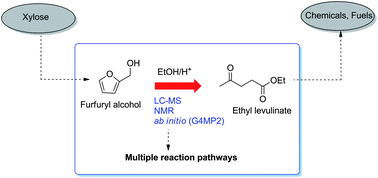Acid-catalyzed conversion of furfuryl alcohol to ethyl levulinate in liquid ethanol†
Abstract
Reaction pathways for the acid-catalyzed conversion of furfuryl alcohol (FAL) to ethyl levulinate (EL) in ethanol were investigated using liquid chromatography-mass spectrometry (LC-MS), 1D and 2D nuclear magnetic resonance (NMR) spectroscopy, and ab initio high-level quantum chemical (G4MP2) calculations. Our combined studies show that the production of EL at high yields from FAL is not accompanied by stoichiometric production of diethyl ether (DEE), indicating that ethoxymethylfuran (EMF) is not an intermediate in the major reaction pathway. Several intermediates were observed using an LC-MS system, and three of these intermediates were isolated and subjected to reaction conditions. The structures of two intermediates were elucidated using 1D and 2D NMR techniques. One of these intermediates is EMF, which forms EL and DEE in a secondary reaction pathway. The second intermediate identified is 4,5,5-triethoxypentan-2-one, which is analogous to one of the intermediates observed in the conversion of FAL to LA in water (i.e. 4,5,5-trihydroxypentan-2-one). Furthermore, conversion of this intermediate to EL again involves the formation of DEE, indicating that it is also part of a secondary pathway. The primary pathway for production of EL involves solvent-assisted transfer of a water molecule from the partially detached protonated hydroxyl group of FAL to a ring carbon, followed by intra-molecular hydrogen shift, where the apparent reaction barrier for the hydrogen shift is relatively smaller in ethanol (21.1 kcal mol−1) than that in water (26.6 kcal mol−1).


 Please wait while we load your content...
Please wait while we load your content...